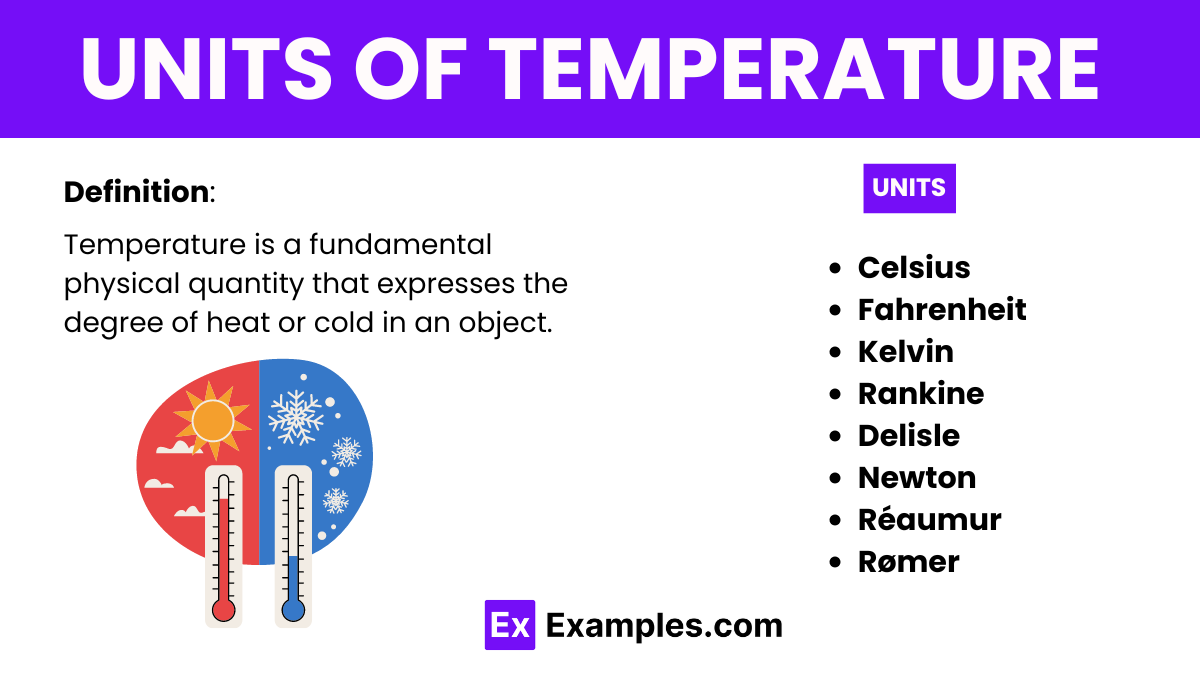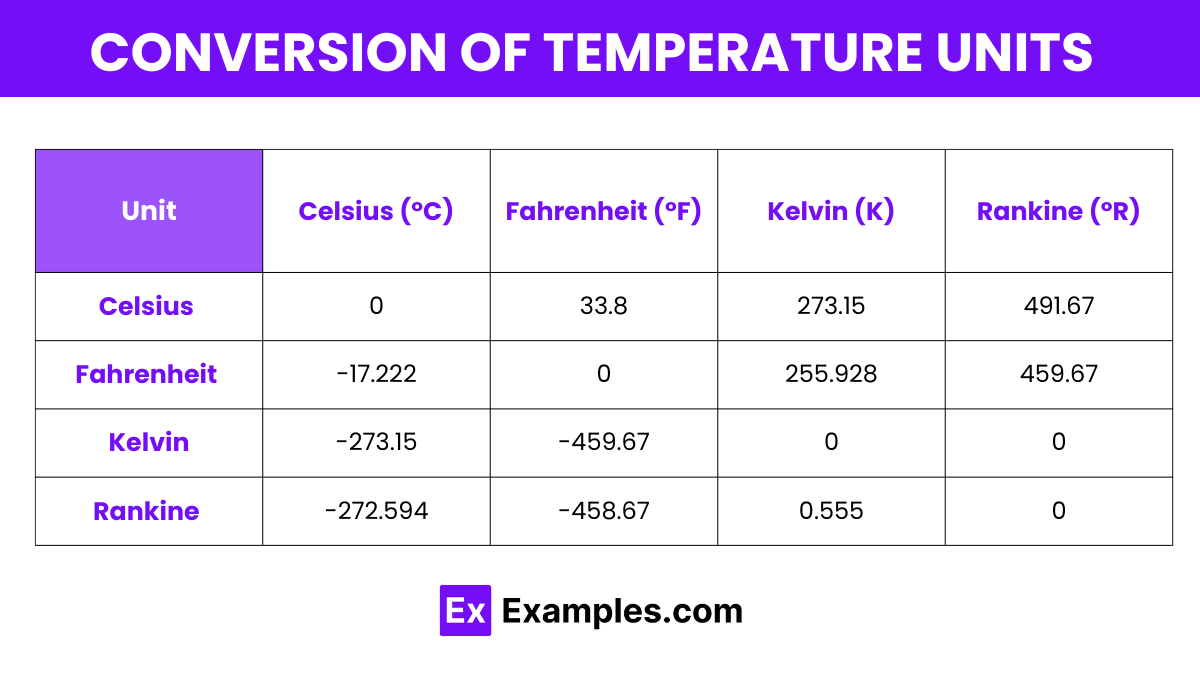What is the SI unit of temperature?
Celsius
Fahrenheit
Kelvin
Rankine


Temperature is a fundamental physical quantity that expresses the degree of heat or cold in an object or environment. It is measured using various units, which are the benchmarks for quantifying temperature levels. The most commonly used units of temperature are Celsius, Fahrenheit, and Kelvin.
Using Kelvin, scientists can communicate temperature measurements in a universally understood way, facilitating easier collaboration and comparison of data across different systems and studies. Kelvin does not use a degree symbol, which sets it apart from Celsius and Fahrenheit, emphasizing its role in scientific accuracy rather than daily weather description.
Anders Celsius developed the Celsius scale, which acts as the primary temperature measurement unit in the Centimeter –Gram–Second(CGS) system. This scale accurately sets the freezing point of water at 0°C and the boiling point at 100°C under standard atmospheric conditions.
Using this scale, scientists and technicians measure temperatures effectively in scenarios where the CGS system is applicable. To convert Celsius to other temperature scales such as Kelvin or Fahrenheit, you add 273.15 to the Celsius reading to find the Kelvin value.
| Unit | Symbol |
|---|---|
| Celsius | °C |
| Fahrenheit | °F |
| Kelvin | K |
| Rankine | °R |
| Delisle | °De |
| Newton | °N |
| Réaumur | °Re |
| Rømer | °Ro |
Celsius is the SI-related unit of temperature used widely around the world. It is defined based on the boiling and freezing points of water, where 0°C is the freezing point and 100°C is the boiling point at standard atmospheric pressure.
Fahrenheit is primarily used in the United States and some Caribbean countries. It defines 32°F as the freezing point of water and 212°F as the boiling point, under standard atmospheric conditions.
Kelvin is the SI unit of thermodynamic temperature and is widely used in science and engineering. It starts from absolute zero, where all thermal motion ceases, defined as 0 K.
Rankine is similar to Kelvin but uses the Fahrenheit scale. Zero Rankine is also absolute zero, but the scale increments correspond to Fahrenheit degrees.
The Delisle scale, invented by Joseph-Nicolas Delisle, is an inverted temperature scale where higher values represent colder temperatures. It sets the boiling point of water at 0°De and decreases by 2/3 degrees Celsius for each degree increase.
Developed by Isaac Newton, this scale is based on a temperature interval defined by the freezing point of water at 0°N and an arbitrary point at 33°N.
The Réaumur scale sets the freezing point of water at 0°Re and the boiling point at 80°Re. It is mostly used in some European countries historically.
This scale, devised by Ole Christensen Rømer, starts with the freezing point of brine at 0°Ro. Water boils at 60°Ro, with each degree Rømer being 40/21 of a Celsius degree.

Here is the table for temperature conversion factors between common units of temperature, formatted similar to the example you provided:
| Temperature Unit | Celsius (°C) | Fahrenheit (°F) | Kelvin (K) | Rankine (°R) |
|---|---|---|---|---|
| Celsius (°C) | 0 | 33.8 | 273.15 | 491.67 |
| Fahrenheit (°F) | -17.222 | 0 | 255.928 | 459.67 |
| Kelvin (K) | -273.15 | -459.67 | 0 | 0 |
| Rankine (°R) | -272.594 | -458.67 | 0.555 | 0 |
Various units for temperature exist due to historical, cultural, and scientific reasons, reflecting diverse measurement systems and contexts in different regions and disciplines.
Temperature is measured using devices like thermometers, which sense thermal changes in materials. These changes, such as expansion or contraction, correlate with temperature variations, providing numerical readings.
The fundamental unit of temperature is the Kelvin. It’s based on the absolute zero point, representing the absence of thermal energy in a substance.
Text prompt
Add Tone
10 Examples of Public speaking
20 Examples of Gas lighting
What is the SI unit of temperature?
Celsius
Fahrenheit
Kelvin
Rankine
What is the freezing point of water in Celsius?
0°C
32°C
100°C
273.15°C
What is the boiling point of water in Fahrenheit?
100°F
212°F
32°F
273°F
How is the Kelvin scale related to the Celsius scale?
K = °C - 273.15
K = °C + 2
K = °C × 273.15
K = °C / 273.15
What is the absolute zero temperature in Celsius?
-273.15°C
0°C
-100°C
-273°C
What unit of temperature is most commonly used in the United States?
Celsius
Kelvin
Fahrenheit
Rankine
How is the Rankine scale related to the Kelvin scale?
R = K + 273.15
R = K - 273.15
R = K / 273.15
R = K × 1.8
What is the freezing point of water in Kelvin?
0 K
100 K
273.15 K
373.15 K
Which temperature scale has the smallest unit increment?
Celsius
Fahrenheit
Kelvin
Rankine
What is the boiling point of water in Kelvin?
100 K
212 K
373.15 K
273.15 K
Before you leave, take our quick quiz to enhance your learning!

